Night of The Living Tech: How Cyber Criminals Can Bring Data Back from The Dead — and What You Can Do About It.
Want to hear something scary? This year, a single data breach that effected more than 76 million people cost T-Mobile 500 million dollars. What is more, a recent study shows that about 52 million data breaches occurred worldwide during the second quarter of 2022 alone, according to Statista.
Even if you remember to clear your computer’s recycling bin, deleted digital files are not gone forever. Cyber criminals, unauthorized users and other technically inclined ghouls have the power to revive your undead files and exploit them. The regulatory fines, legal expenses and reputation damage that could result from such data breaches are truly terrifying.
This spooky season, we are helping you avoid e-waste related nightmares by exploring the ways in which data is brought back from the dead in a fun-sized summary, as well as outlining measures that you can take to keep your company safe and let your retired technology rest in peace.

From Machine to Monster
The transformation of useful equipment into a security risk happens so slowly it can barely be seen. One day, a computer is functioning at peak performance — the next it could find itself plagued with a virus, replaced by a newer model and eventually forgotten in storage or placed in the trash. From there, anyone from a curious hobbyist building a budget PC to a seasoned career hacker may come into contact with your obsolete electronics.
Once in the wrong hands, hard drives, optical media and other sources of sensitive information are subject to various forensic data recovery techniques. One such method, called data carving, is undertaken by parsing raw data for indications of where blocks once began and ended, then filling the parts in between to reanimate deleted files.
Even if your old computers, printers and other devices are utilized by strangers for legal everyday activities like browsing the internet and completing homework, the data they contain is still not safe from attack. Hackers from around the world can target your organization’s sensitive information remotely via the web.
Let Your Data Rest in Peace
Software is available to overwrite deleted files and make unauthorized access slightly more difficult, but it cannot fully prevent it. While this measure may be acceptable for personal consumer electronics — formal organizations and companies require more comprehensive solutions. In fact, if your company handles medical, financial or other legally protected information, proper electronics disposal is likely mandatory.
If you want to be sure your data doesn’t come back to haunt you, consider working with a professional electronics recycling company. In doing so, you can be confident that your data has been completely destroyed and all physical components have been disposed of responsibly.
Reputable electronics recyclers, like our team at PC Survivors, hold RIOS and R2v3 certifications for best practices as well as strictly adhere to the requirements outlined by HIPAA, Gramm Leach Bliley, GDPR and all other applicable regulations.
You can have your e-waste processed at our facility or we can bring our mobile shredders and other portable equipment to your place of business and conduct our services on-site. Upon completion, if requested, you will receive a detailed certificate of proper data destruction for your records.







